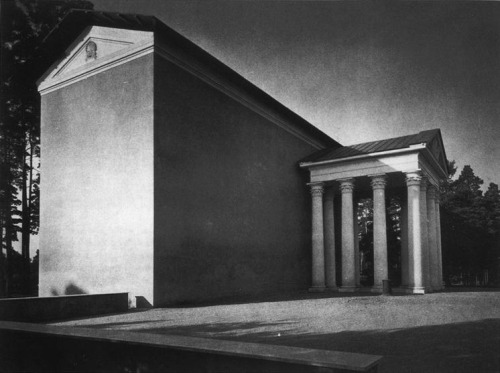
Chapel of the Resurrection, Skogskyrkogården, Stockholm 1925. Sigurd Lewerentz architect.
“Belonging to or identifying oneself with a religious body in America today certainly does not mean that one thereby takes over the traditional Christian values of tolerance brotherhood, and equality. On the contrary, it appears that these values are more firmly held by people who do not affiliate with any religious group.”
The Authoritarian Personality (Adorno et al).
“It seems that Lewerentz was at various times leading and directed by this melancholia, and all that is inherent in its meaning. This fact became most explicit at Lewerentz’s Resurrection Chapel at Woodland Cemetery in Stockholm. The pure starkness of the form is anchored in the studied geometry of the golden section, while the offset entry portico is pulled from the façade and held slightly off axis. These formal gestures are unprecedented in similar classical work of the time and inculcate the complex with a charged strangeness, appropriately reinforcing the program of procession from life to death.”
Thomas Ryan
I want to pull together several threads, or trends in thinking in the U.S. today, particularly the U.S. but it’s true in the U.K. to a lesser extent and perhaps in western Europe even. The ways in which anti intellectualism appear in the meta discourse of media and news outlets, and how the same anti intellectualism is applied to culture, and how, also, there is a growing attachment, or an almost obsessional sort, to images and stories and ideas of Empire, feudalism, and aristocracy.

Jackie with Rachel *Bunny* Mellon.
In New York, at the Sotheby’s auction, a Rothko was sold for 75 Million dollars, a Warhol silkscreen sold for 16 million, a record for a work on paper, a Richter for 17.4 million, and a Francis Bacon for just under 30 mil. The reaction, if one were to survey social media, was uniformly to ridicule the artworks, not to criticize the auction house, the billionaire collectors, or the galleries involved. It was to blame the artists, the vast majority of whom are dead. Never mind Rothko was a strongly left leaning supporter of civil rights, a darkly depressive man, but one of great integrity; no, from most of this ever more philistine American class, the mildly reactionary white people class, there comes ridicule. From the left comes ridicule and hostility (and the almost pathological obsession with exaggerating and distorting the CIA attempt to co-op ‘the New York school’.) Why is this? Well, on both counts because it fits into easy to digest narratives. For the yahoos in Rubeville the snide “oh hell, I could do one of those a day” (which I actually read on a facebook thread) is the general response. The logic of which implies virtuosity as the goal — expertise and mastery of technique, but only a technique that results in recognizable realism. The left will point to the financialization of the art market, rightly, but also dismiss AbEx painters as inherently reactionary and/or masculinist, or whatever. For it’s always something. But see, what both these perspectives share is a dislike of enthusiasm for art.

Jean Pascal Flavien
The left must point out the uses to which art-products are used — but also imply within that critique that the works themselves sort of inherently contained elements ASKING to be compromised and turned into decor for the CEO’s office at Exxon. A bit like blaming Muslims for wanting to be occupied because they wont control their culture (sic) or black people for being inherently criminal and irresponsible.
Capitalism can absorb anything. Turn anything into the commodity it wants it to be. Capitalism will also stigmatize the victims. At every every every every turn. Every one. The victim did something to bring calamity upon themselves. But how often do you hear leftists wax enthusiastic about art? Rarely. Some will applaud various obscure overtly leftist stories, but rarely if ever have I heard a leftist discuss Still’s work with color, or how to approach Stella’s black work. No, but I bet you *have* heard them praise the Mexican muralists.
Worth noting that Rothko’s work, or the majority of his important paintings, were bought by Listerine heiress Bunny Mellon, wife of Paul Mellon. Bunny planted the White House rose garden. I guess, as a sort of, let the old coot have a hobby gesture. But she owned two ten million dollar apartments in Paris, huge mansions in Antigua, Cape Cod, and Nantucket, as well as a massive 4000 acre estate in Virginia with its own landing strip for her private jet, and a Park Ave townhouse in NY. She financed John Edwards campaign, amusingly, and lived to be 103. The Mellons palled around with the Kennedy’s, and were an obvious part of the American ruling class. A parasitic vampiric ghoulish class of white WASP banking families whose tentacles extended into all facets of corporate America. This, this is who bought up Rothko, and paid, it is rumored, ten thousand to twenty thousand a painting — though she bought in groups. In Rothko’s later years his larger paintings sold for about twelve grand.

John Haberle
There is a bad play now about Rothko, and snide really resentful articles by the likes of William Boyd. Why this hostility? Boyd of course is his own brand of self aggrandizing philistine. Still, such hostility at the art itself, never mind the long dead artist, seems symptomatic of the anti intellectualism I find everywhere. Adorno warned that Americans were prone to the appeal of mastery and technique — the residue of Puritanism and the Protestant work ethic. Practice practice practice. It is curious, though, how this notion of practice evolved in Asia, vs North America. In that stretch of time between WW1 and WW2, a certain coalescing of cultural attitude took place in the U.S. Evan Connell’s novellas Mrs Bridge and Mr Bridge capture the stoic repressed flinty character of midwestern America. Dreiser did so a decade or two or three earlier. As a quick sidebar: Connell was always deserving of greater acclaim, but seemed in the shadow of Roth and especially Updike. As I believe Joshua Ferris once said of Connell, ‘he captured something of the boredom of the unexamined life’. In retrospect, Connell’s prose is clear, unadorned, and yet very fluid. Something I’d not say of Updike.
“Theory is theory in the authentic sense only where it serves practice. Theory that wishes to be sufficient unto itself is bad theory.”
Horkheimer

Woodland Cemetary, Crematorium. Johan Celsing, architect. 2013
There is in this anti intellectualism a specific nostalgia for Victorian England and for colonial style, and an age of servants and what is perceived as refinement. Alongside this is another nostalgia for feudalism; an imagined sword and scorcery realm of castles and knights and serfs. In both the role of the servant looms very large. Penny Dreadful to Downton Abbey, to Mr Selfridge, to Game of Thrones, to the countless variants on Jane Austin-lite romances. It is of course more understandable that the UK produce some of this, it’s actually an organic part of their culture. More perverse is the U.S. longing for this. I am expecting a wave of network and cable drama with the gilded age as a backdrop. The Boss Tweed narratives, only with Carnegie and Mellon, Stanford, and Rockefeller as somehow the heroes.
The more germane factor in this growing fascination with the depiction of servants is that it is also projected forward into futuristic landscapes. Hence, it is deemed natural. There are servants and there are rulers. Natural law.

Gregory Johnston
One of the issues with the new philistinism is its relationship to notions of realism. And realism with its foundation in mastery. In contemporary Hollywood film, awash in CGI and various techniques of color grading, realism has taken on certain cues related to technology. As Dan Seitz pointed out, Hollywood color codes according to genre (i.e. futuristic apocalypse films are grey and de-saturated, horror films are blue tinted, and sci-fi such as Matrix are green, etc). But everything else has been accorded teal and orange. This is because audience testing suggests teal and orange (opposites on the color wheel) are most *appealing*. The computer color correction has now, for big budget studio product, made everything teal and orange. I seem to recall ages ago that restaurant research, for many franchises, determined that purple and orange made you eat faster. Never mind this is more pseudo science, the result was a decade of fast food joints decorated in orange and purple. (here is the updated research https://www.swipely.com/blog/building-customer-loyalty-color-experts-rank-best-restaurant-colors/ The Cohn Brothers ushered in the era of DI (Digital Intermediary) with Oh Brother, Where Art Thou, the first feature entirely scanned into a computer for color correcting. But the point here is that these cues have been increasingly internalized for determining what is ‘realistic’.
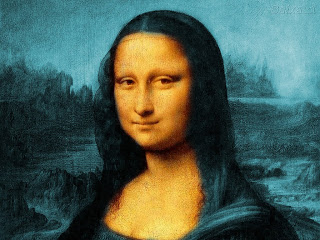
Color corrected Mona Lisa (courtesy of Into the Abyss blog).
This connects in a way with Laura Mulvey’s The Index and The Uncanny. Still photography, per Rosalind Krauss stood at the crossroads of science and spiritualism. Which might be the best single line Krauss ever wrote.
“Hence the charm of family albums.Those gray or sepia shadows,phantom like and almost indecipherable,are no longer traditional family portraits but rather the disturbing presence of lives halted at a set moment in their duration,freed from their destiny; not however by the prestige of art but by the power of an impassive mechanical process:for photography does not create eternity as art does,it embalms time,rescuing it simply from its own proper corruption.”
Andre Bazin
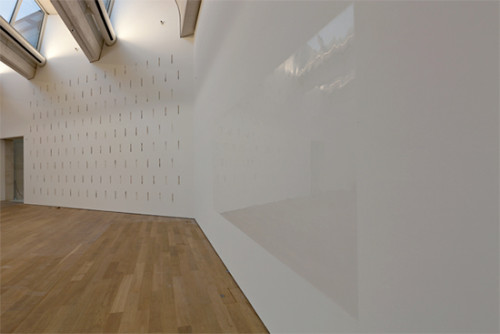
Karin Sander, at Esther Schipper Gallery.
In a sense Mulvey was asking what was the tense of the photograph. Benjamin was fascinated with this as well, and Barthes. For early photography seemed to capture some aspect of time that has gone missing in the age of the digital. The photograph lent itself as well to Lacan’s notion of the Real. Something outside what language could define. It may be that what this really was addressing was a sense of the uncanny, and it’s relationship to our own sense of mortality. There is no question that still photographs often inscribe an illusive quality that seems connected to death. I was thinking this week of the architecture of cemeteries and crematoriums.
“There is the difficulty of conceptualizing fully the inhuman nature of the camera machine and its ability to hold time,but there is also the resonance of death that culture and the human imagination have associated with photographic images.From this perspective,the slippage of language is a symptom of the presence of death and its inevitability.”
Laura Mulvey
The Nordic classicism of Sigurd Lewerentz reached its zenith in the Chapel of the Resurrection, built early in his career. There is the sense of death in the absent windows. The architectural grammar of the portico, the asymmetry of the entrance, and counter intuitive quality of scale. This is an uncanny building. But here there is a question having to do with the sense of viewing the still photo, and for that matter, the viewing of all artwork objects. But the photograph has a special place because of its quality of recording an instant. The viewer may stare for hours at the recorded *instant*. Somehow such contemplation invariably leads to an experience of the uncanny. Adorno saw a repression of the effects of modern art. A peculiarly modern experience that is given some credence by the growing sense of repression and denial in contemporary society of the trauma of life under a system of acute inequality. On the one hand there is a romanticizing of the feudal and of indentured servitude, and on the other a willful blindness to poverty and homelessness. The return, as Anthony Vidler pointed out (and Bhabha)of migrants and the diasporic, to the cities of the colonizer, have created a psychic rift and anxiety in the white educated classes of the West.

Ambrosius Bosschaert the Elder.
“Trauma leaves a mark on the unconscious,a kind of index of the psyche that parallels the photograph’s trace of an original event.”
Laura Mulvey
So, there is an increasing desire for a doubled repression, which is partly expressed in this new anti-intellectualism. Bhabba insightfully writes…“that boundary that secures the cohesive limits of the western nations may imperceptibly turn into a contentious internal liminality that provides a place which to speak of, and as, the minority, the exilic, the marginal and emergent.” Vidler suggests architecture as the most acute metaphorical home for the uncanny. Looking at modern cemetery architecture would seem to reflect the truth of this.
“Years after coining “the culture industry,” Adorno (1967/1975) reflected that the word “mass” was excluded from the phrase because it was a dangerous word. The word “mass” might give the reader the wrong impression: that the culture industry contained “something like a culture that arises spontaneously from the masses themselves” (p. 12). In the culture industry, the audience may select programs, buy tickets, or change channels, but in doing so, each person acts as “an object of calculation; an appendage of the machinery” (p. 12). While some misguided analysts might see this as “even democratic, since it responds to a demand” (p. 16), in fact the demands are produced and ultimately shaped by the industrial apparatus itself. The culture industry is a sham democracy that solicits input only for its own ends. The culture industry produces the audience; it is not governed by them.”
Christian Sandvig
and
“…social media have also now evolved into an elaborate system that selects social products and makes them popular based on obscure determinations of economic value. Social media platforms filter, censor, control, and train—and they may do so without the user’s awareness. Advances in computation now make a social media industry possible that is based on individual difference and action rather than sameness and passivity. But in other respects, the social industry resembles the culture industry: the co-option of culture has been superseded by the co-option of sociality.”
Sandvig

Sergey Novikov, photography. Abandoned movie theatre, Moscow.
Today, the anti-intellectualism finds expression on both the right, and in a new faux left that assumes a posture of savvy entrepreneurial superiority. The truth is, of course, that this new left is only radical in its infantilism. Today, the escalation in the circulation of image has taken along with it the de-contextualizing of much of what was often the ideological formative impulse for its creation. Things are just packaged and sold and repackaged and resold again. Each time they shed some of the, often, radical political meaning of the original. Audiences in the U.S. are now expecting juvenile material, and almost always the familiar. Anything that demands real focused attention is usually dismissed or ignored. The post modern in architecture seems to have intuited that nostalgia was losing its traction and the missing was resurfacing in disquieting ways. As far back as the 1940s, both Adorno and Benjamin noted that ‘dwelling’ was increasingly impossible. Today there are experts in place to determine the colors and location of things such as windows or garages all in the effort to please the consumer. All based on testing and market research. Such research of course is itself an example not just of magical thinking and pseudo science, but of the alienation effect that lingers at the edges of most modern urban buildings. This is also an expression of the collective anxiety of the ruling class.

House, London. David Adjaye, architect. (Dezeen magazine).
“A growing body of research indicates that race/ethnicity, class, and insurance coverage are key indicators of who receives an ADHD diagnosis and medication (Morgan, Staff, Hillemeier, Farkas & Maczugia 2013; Safer & Malever 2000). These factors play a significant role in the labeling of youth in particular; study after study shows racial disparities in the diagnosis and treatment of ADHD as well as other Disruptive Behavior Disorders, with the indication that teachers were most likely to expect and define ADHD as an issue for white boys (Currie 2005; Safer& Malever 2000). Since research has found no indication that African youth violate rules at higher rates than other groups (Skiba 2002), the persistence of stereotypes of young male males and ‘cultural miscommunication’ between students and teachers is oft cited as one key factor. 83 percent of the nation’s teaching ranks are filled by whites, mostly women, and stereotypes can shape the decision to suspend or expel. The highest rates of racially disproportionate discipline are found in states that have low minority populations, indicating that boys of color are potentially threatening to white teachers, even in small numbers (Witt 2007).”
Nancy A. Heitzeg
Anti intellectualism is, naturally, also a part of how magical thinking is constructed. ADHD diagnoses are a part of how white supremacism is maintained. Fear is being stoked all the time, and Ms Heitzeg’s article on race and a medicalized neo colonial narrative for education, is only another example. The colonial logic is working all the time. The image of black youth is imbued with menace, but also with ideas of deficiency and limitation. Black students are not able to study. White students sometimes have medical issues that interfere with their ability to learn.

Maria Letizia Piantoni, photography.
So, Mulvey also mentions digital photography when she suggested that digitalization dis-indexes the photograph. There is nothing, no-thing, prior to the image. This total simulacrum is possibly resulting in a desire for the object. For the sense of materiality that has felt absent in culture. And perhaps, at least if I speak personally, this accounts for my increasing interest and attraction to work like Lewerentz or Ludwig Leo, but also to voices that express something magisterial in our mortality. Conrad wrote…“The amazing wonder of the deep is its unfathomable cruelty.” The anxiety of white America today is partly born of its utter triviality. The obvious need to deny that catastrophe looms at every turn; water shortages, toxins in food, and dying seas. Conrad’s sea’s cruelty is being felt in new ways today.
One of the crucial roles that art plays, it seems to me, is to make us aware, of mortality. Ronald R. MacDonald’s seminal book The Burial Places of Memory (Epic Underworlds in Vergil, Dante, and Milton) writes “we are forced to concede that language is not a piece of glass through which we can serenely view an undistorted world, but inveitably a distorting mediation. In the mouth of an obscurantist it can become a destructive weapon.” Mass culture is the voice of the obscurantist. If Lacan is correct about Freud’s notion of the death drive, seeing in it the crucial element in psychoanalysis, by way of the subject’s relation to the signifier, then a society of such sadism and lack of remorse or conscience, is one in which an infinite regress is taking place. A society that is reducing itself to an exhaustion of energy, to that abyss and to the death drive. Freud realized early on, in his early idea of *binding* (later to become Eros) that repetition was relatively impossible to really explain. It requires something prior or anterior. Such a psychic journey for Freud is a journey, it seems to me, that is made by all artists of tragic character. It is Dante and it is Virgil, and it is Shakespeare. And it is is Melville and Conrad, and Rothko and Pollack and Neruda and Lorca and Pasolini and Dreyer. In all cases the forces of history interceded to create that synthesis that is also the character of great art. But it seems to me that Capitalism, in its later stages today, especially, is one of truly malignant repetitive regression. The art that is applauded today is always that which interrupts journey.
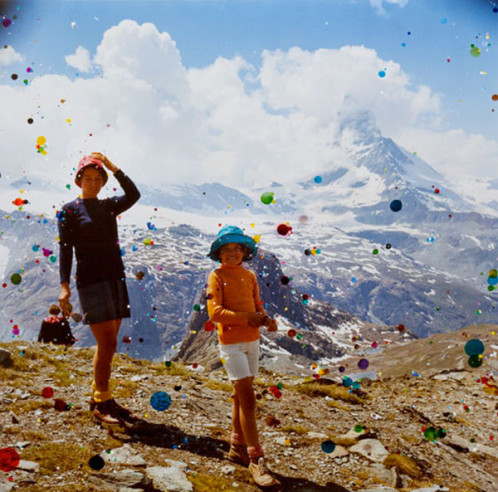
Sebastiaan Bremer
It is worth a small side bar note on the concluding episodes of Mad Men. For a variety of reasons this show resonated in ways many other highly popular prestige series did not. For seven seasons the appearance of journey was taking place. And indeed, there were genuinely brilliant episodes, and scenes. But at the end of the Don Draper saga, one in which the past casts a long stark shadow, the end of the road is Big Sur, a caricature hippie retreat, where Don’s essential shallowness is exposed and his moment of satori is to divine a Coke commercial. A life recuperated by a marketing insight. The creation of Draper promised potential for something quite singular in TV, but it never materialized.
To read the ever trivializing Emily Nussbaum in the New Yorker, this episode was sheer brilliance. Don is Emily and Emily is Don.
It is worth noting Nussbaum because she is the poster girl for a certain entrenched white elitist liberal attitude. Her voice is no different than the voice of Samantha Power or Victoria Nuland or Jen Psaki. And really this is the Obama’s voice, too, and that of most of Washington, and corporate media. They inbreed, these people. They marry their class. They have been trained to do this and they obey. Psaki married Greg Mecher, errand boy to Rahm Emanuel. The voice of The New Yorker in general is echoed in Nussbaum. It is Lena Dunham’s voice, too, and it the voice, partly, of studio Hollywood. These are the voices that safeguard the Empire every bit as much as Petreaus or Dow or Boeing or DynCorp or Lockheed-Martin.
Lacan said the death drive was foundational to the symbolic order. The imaginary is that of the narcissist and stays childish. But the death drive is also something more mysterious. The idea of binding, as Samuel Weber observes is linked at its core to ‘representation’. The binding energy must be bound to something, and so to exist really, it is, even in its primary state, bound to perceptual reality. Our primary relationship to desire, then, is perceptual, representational. For the purposes of this post, my point is that…if the ego organizes via narcissistic identification, then representations of identity, or self, are primary. And these representations, born of energy and stimuli, are recognized because of repetition. Only by repeating can this assembling process solidify. The child’s ability to endure and even demand endless repetition of their favorite story is suggestive of the pleasure their narcissistic little egos take from the familiarity of this feeling. Now, of course the representations that are formed are still shaped by the historical moment. The meta-anthropology of Freud sees society is in a dynamic of impulse or instinct modification. Out of that tension the various sublimations… including art…are a way of rejecting or managing aggression. Except that I believe that Lacan spotted something significant in how narrative and art, the narratives implied or embedded in all artworks, are ways of learning to navigate our own existence, and come to some relationship with our eventual death. And more, that the forces of aggression, of violence, are linked with an adjustment made by the narcissistic personality that seeks to master itself by first mastering others. There is a primal deformity that demands *others* be reduced in order for representations (of self, identity) to not self destruct. There are contradictions in Freud, and one of the most basic is, in fact, that of repetition. Freud sees the repetition compulsion expressing an energy and force of repressed material. And yet repressed material is always desire. And desire is pleasure. But, it is in such contradiction that truths are found.
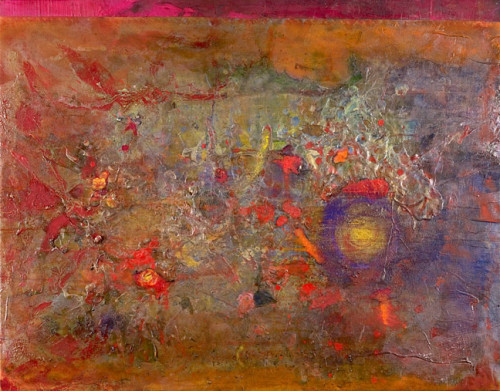
Frank Bowling
Art is always linked to repetition. Practice, rehearsal, training. Self denial, bordering on masochism. And stories are always repeated stories. The idea of representation leads on, of course to allegory and metaphor and symbolism. The creation of space, of ‘a’ space, in which language can form a grammar to describe our experience. Or, our experience shapes itself to grammar. The sense of leaving the womb, the trauma of not being home, becomes a variety of story. The figure of the exile is there throughout the world. Throughout history. The exile must escape danger and threat. The stranger is our first visitor. History is shaped and made by man, and in turn it makes man. Language is formed in conjunction with image, with the making of marks and then with text. But the stranger is also a strange language. In Dante’s hell, desire is more acute than anywhere else.
“and they are eager to cross the stream, for Divine Justice so spurs them that their fear is changed into desire.”
The Inferno
But the destructive nature of compromised story, of today’s mass cultural regression is in how story rejects journey. Don Draper goes nowhere to find nothing. Awakening is a cola commercial. A cynical one at that. In Wisconsin there are now acute limitations in what recipients can buy with their food stamps. You cannot buy most potatos. You cannot buy soy milk. Or ketchup. Institutional cruelty. Mass incarceration is not enough. The people who create this sadistic legislation are having to ramp up an erasing of the material world. The governmental racism is so naked and open that I suspect soon there wont even be fig leafs applied to cover it up. There are counter forces, certainly. Anti death penalty activists have made genuine progress. But over all this is a society of domination.
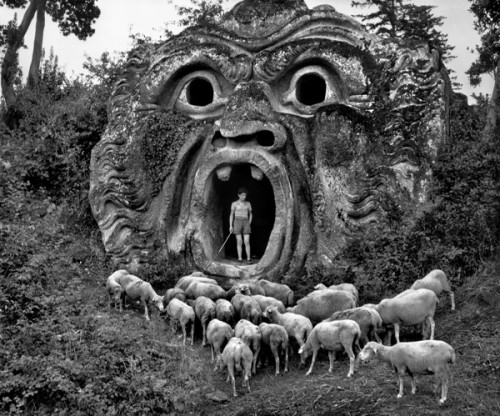
Herbert List, photography. Bomarzo, Park of the Palazzo Orsini. 1952
“…what the drives repeat is neither a ground nor an abyss, but a violent process of inscription, alteration and perhaps above all: narration.”
Samuel Weber
Weber is saying that this unrepresentable origin, is in fact a representation of representation. This is why I continue to insist that aesthetics have an important political dimension. For stories involve very primary processes of engagement with the Other. If the stories that society today favors are stories meant to obscure, are being used as weapons to control and punish, then a failure to more closely read them is highly problematic. Deleuze said creation was an act of resistance. To death, but also to a paradigm of control in today’s society of domination. But it has to be remembered that this paradigm now counterfeits story. It is a paradigm of controlling narrative. It is easy to see the propaganda of Hollywood war films or TV, but it is less easy to grasp why so much prestige culture is equally, if not more, destructive.
Martha Rosler:
“A more general cultural delegitimization than the questioning of photographic truth is at work in the industrial societies. This delegitimization is as much a product of political failure as of image societies, and it entails the declining faith in the project of modernity and its religion of *progress*. In describing its material basis (though not, one must hope, in his totalized conclusions), Debord was surely correct to locate the genesis of *the society of the spectacle* in the process of capitalist industrial production and the dominance of the commodity form — despite Baudrillard’s attempted correction to Debord’s theory to the interchangeability not of commodities, but of signs…the real danger is that people will choose fantasy, and fantasy identification with power, over a threatening or intolerably dislocating social reality.”
Public (in the West) acceptance of political theatre is a by product of hegemonic control of the information industry. Today, the general public has become familiar with the cues and props of this electronic theatre and read the ‘stories’ of foreign wars and occupation as they read kitsch movies. Rosler’s point, really, was that ideas of evidence and truth are no longer seen as important. Reality can be color corrected, after all. Illusion IS evidence. The interior landscape of contemporary consciousness is now finding it easier to believe the obviously manufactured, and to view cultural works that demand interrogation and contemplation as needless and antiquated.

More stupidity only this time from the New Yorker…oh what a surprise…http://www.newyorker.com/culture/cultural-comment/the-original-resonant-existentially-brilliant-mad-men-finale
In Ireland I continually notice two types of anti-intellectualism. The first is explicit and perhaps the less worrying – in our government, our populist politicians, who are all in bed with business regardless of how left or right leaning they are, earn brownie points on a day to day basis in the parliament with tried and tested speeches rejecting “the ivory tower” the “professors” etc… This has always been the way with government in Ireland. I think it began historically as a result of colonial british rule, and Irish catholicism which forbid those who weren’t priests from reading religious books, though I might be wrong.
Anyway it is definitely the case that a canny sharp distrust of books, or education, has always flown in our parliament, and debates on crucial issues are always won on that basis. National heroes are defiantly anti-intellectual businessmen such as Michael O’Leary, the CEO of the low cost airline Ryanair. Now that the country is in the grip of a genuine and agitative foment because of water charges, one of the government’s central tactic in suppressing it is to portray the handful of brave and principled left leaning politicians (all independent) fighting the charges as “professors” “pamphlet reading theorists” etc… and sadly it flies, because Ireland, more than any other country in Europe, I think, is adopting the american model of casino capitalism wholesale – demonstrable in the amount of american multi national tech companies cosied up to our government in return for the most lax tax laws for big business in western europe. All of this ideology trickles down to the man or woman on the street who are working zero hours contracts round the clock, but lap it up, because of the false promise of success. Worse than that, many hate their fellow citizens in the public sector, or those who are homeless or in poverty.
The second form of anti-intellectualism is more pernicious and one that I think of a lot reading your blog, John. It manifests in the university educated liberals, who are convinced of their own enlightenment… the swathe of society that rejects most art as difficult or high falutin’, and because of their level of education (up to PhD) reject it with a self-important authority, and in place of it, raise the mediocre, the glib, the intellectually dishonest, and most frightening of all, the ideologically suspect. Time and again, I encounter acquaintances, or on twitter people I know less well, who actually create the arts agenda in Ireland bullying anything true or challenging out of the picture, kicking it into touch, to be replaced with the trite propaganda of the arts establishment in Ireland, which is no different to the actual establishment, most of them having come from families belonging to the elitist ruling political party Fine Gael. These people continually perpetuate a nationwide confidence trick that their anointed propoganda is “the arts” in Ireland. Anything that questions the status quo will never stand a chance. Never mind Joyce, Kafka is the writer who has most to say on modern Ireland, a bureaucratic hell, in service to an elite that is intellectually ignorant but, to a person, sharp as texas card sharps when it comes to the smell of money, and power.
well, the intellectualism we’re left with seems to be a kind of hypervigilence by critics over trivia. I read a big New Yorker piece questioning the English translation of a single word in a title by Camus, and I kept wondering, “is this what worlds turn on?” . I suppose some educated people will read that and go, “hmmm…that seems important.” You see the same thing in the daily news … especially political coverage, where everyone appears to be going to the wall over something like the rights of the transgendered to their own washrooms in some midwestern town. I agree, that’s something worth examining, but the proportion is out of whack. If some serious public debate over culture ever does erupt, it will be some kind of Derridian deconstruction of what if anything those colour swirls by Peter Max meant, and if they should be banned from public buildings. The comments by Sandvig are interesting. Every time I see an instagram photo lauded as high art I find myself driven back to those black and white photo essay books from the ’70s, Family of Man and so on, and wonder why the drab, one dimensional pictures of Diane Arbus and Steiglitz, and even Man Ray, appeal to me. I finally asked a photographer why they were so compelling and he just kind of shrugged, saying there’s a lot of technique in them, and a rather messy one at that; silver emulsion and darkrooms and chemicals that can drive you mad. I’d have to say it’s because the technology did not overshadow the subject, and I liked the ugliness of them. And the ugliness of the technology used. They had Hasselblads, not pretty or sexy and nobody outside the profession ever wanted to use them. We used Polaroid swinger cameras. It’s kind of the same with pre Star Wars science fiction, Logan’s Run and Zardoz and that apey one. They were all plot, not Industrial Light & Magic. Anyone can shoot beautiful photographs with an iPhone. But all that luscious colour saturation, perfect light exposure, and unlimited detail is wasted on something subject worthy. The subject cannot distract from the perfection of the shot. I like imperfect photography. Nobody wants to shoot real life with an iPhone, much less the ugliness of it. I saw a photo essay recently of prostitutes in Bangladesh. They were stunning, but I kept thinking, “prostitutes in third world countries do not look like this. they are being falsely portrayed. not by what they were wearing or doing or where they were, but the slick digital reproduction of their likeness. Comparing those old photographs of the Viet Nam war, with contemporary photojournalism of Syria is interesting. In the later we see the detail, we don’t see the picture. The subject is a distraction from the technology.
..as for the appeal of servitude, in popular shows like Downtown Abby, I think it stems from a collective sense of guilt. Like we all need to atone for something. What better way than prostrating yourself in front of an authority figure? I suppose this is a kind of latent, or resurgent, sense of puritanism, just something that rears up every century or so, like a virus. There are clues in plays like The Crucible by Arthur Miller, or The Handmaid’s Tale by Margaret Atwood, who is actually a fairly good futurist for a novelist. I doubt there’s anything that can be done about it, beyond waiting for it to peter out. Maybe we’ll have a new golden age immediately after.
the perfect image for “corrected reality” is a correctional institution (take your pick)
Urgent to the Federation of Galactic Councils
Re: Survival of planet Earth, solar system ExB213, galaxy MaDas/5
Situation critical; very close to destruction; request immediate intervention; inequity factor is 1,000,000,000 [one billion] and rising; most powerful species is victim of bigpicture blindness; cannot see the overall situation; this species has technology and weapons capable of destroying entire planet 60 times over; please send emergency response team ASAP; code 10; need equipment for disabling uranium-based bombs; repeat: extreme inequity increasing exponentially, driving violence to infinity; planet could burn at any moment; species has very confused and imperfect ideas about work and wealth; self-destruction is rampant since reward and sacrifice were divorced; species lacks conscious perception of value of justice and of connection of injustice and violence; recommend you send 1000 indestructible teachers; species has driven itself mad; most unable to overcome inertia, many vulnerable to psychosis and panic mentality; obedience to custom and convention is solidified; submission to accepted ideas is extreme; sense of alarm at situation is extremely slight; recommend extreme caution; planet is worth saving, has some interesting lifeforms – and a few good works of art